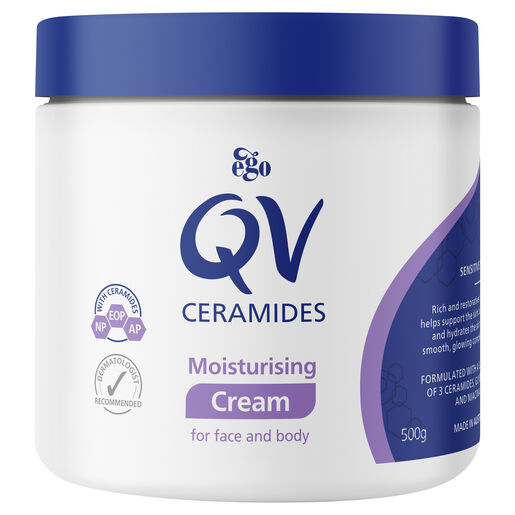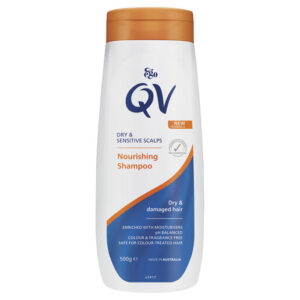ALWAYS READ THE LABEL AND FOLLOW THE DIRECTIONS FOR USE
PLEASE REFER TO ANY HEALTH AND PRODUCT WARNINGS BELOW
If symptoms persist talk to your healthcare professional. This product may not be right for you. Read the warnings before purchase. Please refer to any health and product warnings below.
General Information
QV Ceramides Cream contains rich & deeply hydrating triple ceramide (EOP, NP, AP) and triple moisturising cream formulation with niacinamide to promote a healthy skin barrier for hydrated and rejuvenated glowing skin and up to 24 hour hydration. Dermatologist recommended & tested.
Suitable For: Sensitive, eczema-prone and acne-prone skin on the face and body
Size: 500g
KEY FEATURES
- Rich & deeply hydrating triple ceramide (EOP, NP, AP) and triple moisturising cream formulation with niacinamide to promote a healthy skin barrier for hydrated and rejuvenated glowing skin and up to 24hr hydration
- Formulated with a blend of 3 ceramides, glycerin & niacinamide
- 24-hour hydration
- Improved trans epidermal water loss
- Dermatologist recommended & tested
- Rich, triple moisturising formulation
- Suitable for use with sensitive, eczema-prone and acne-prone skin on the face and body
Directions For Use
Use morning and night. Moisten face or body with water. Lather small amount of cleanser on hands and then gentle massage onto skin. Rinse thoroughly with clean water. Follow up with QV Ceramides Moisturising Lotion or QV Ceramides Moisturising Cream.
STORAGE AND DISPOSAL
Store below 30°C.
Warnings
Avoid eyes. For external use only. If lather enters eyes, rinse with clean water. If irritation occurs, discontinue use.
Ingredients
Aqua (Water), Glycerin, Paraffinum Liquidum, Petrolatum, Cetearyl Alcohol, Dimethicone, Ceteareth-20, Stearic Acid, Glyceryl Stearate, Squalane, Laureth-3, Methylparaben, Dichlorobenzyl Alcohol, Sodium Lauroyl Lactylate, Niacinamide, Ceramide AP, Ceramide NP, Ceramide EOP, Phytosphingosine, Cholesterol, Xanthan Gum, Carbomer, Ethylhexylglycerin.
SUSTAINABILITY
Rating: Moderate
- Aqua (Water): Water is renewable but conservation is important, especially in regions with water scarcity.
- Glycerin: Typically, plant-derived, biodegradable, and sustainable if sourced responsibly.
- Paraffinum Liquidum (Mineral Oil): Derived from petroleum, non-renewable and non-biodegradable, with a high environmental impact.
- Petrolatum – Low: A petroleum derivative, non-renewable and non-biodegradable, contributing to environmental pollution.
- Cetearyl Alcohol: Derived from plant oils, biodegradable, and renewable when sourced sustainably.
- Dimethicone: A synthetic silicone polymer, non-biodegradable and derived from petroleum, contributing to environmental persistence.
- Ceteareth-20: A synthetic emulsifier, not biodegradable and derived from petroleum, but with moderate environmental impact.
- Stearic Acid: Derived from plant oils or animal fats; renewable and biodegradable if plant-sourced.
- Glyceryl Stearate: Derived from plant oils, biodegradable, and sustainable if plant-sourced.
- Squalane: Can be sourced from olives or sugarcane, making it renewable and biodegradable when sourced from plants.
- Laureth-3: A synthetic surfactant and emulsifier, non-biodegradable with environmental persistence.
- Methylparaben: A synthetic preservative, biodegradable with low environmental impact but still contributes some pollution.
- Dichlorobenzyl Alcohol: A synthetic antimicrobial agent, non-biodegradable, contributing to environmental persistence.
- Sodium Lauroyl Lactylate: A natural, biodegradable surfactant, sustainable when plant-based.
- Niacinamide: A synthetic form of Vitamin B3 with moderate environmental impact, but biodegradable.
- Ceramide AP, Ceramide NP, Ceramide EOP: Plant-based or synthesized sphingolipids; sustainable when plant-derived and produced responsibly.
- Phytosphingosine: A naturally occurring lipid from plant sources, biodegradable and sustainable with proper sourcing.
- Cholesterol: Can be derived from animal sources (less sustainable) or plants (more sustainable). Plant-derived cholesterol is the more sustainable option.
- Xanthan Gum: A natural, biodegradable polysaccharide produced through fermentation, highly sustainable.
- Carbomer: A synthetic polymer, non-biodegradable, with a significant environmental footprint due to petrochemical origins.
- Ethylhexylglycerin: A synthetic preservative, biodegradable with moderate environmental impact.
Disclaimer
PRODUCT DETAIL DISCLAIMER
Botanical Chemist Palm Cove strives to provide accurate and up-to-date product information, including images, ingredients, nutritional facts and more. However, product details may change and there may be delays in making updates. For the most accurate and current information, please refer to the product label or contact the manufacturer directly. For therapeutic goods, always read the label and follow the directions for use.
PRODUCT PRICE DISCLAIMER
Product prices are displayed based on your current location. Please be aware that prices may vary between our Botanical Chemist Palm Cove retail outlet and online store.





